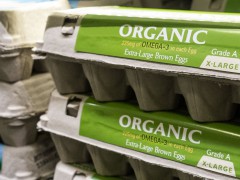by Jack Hornickel
The USDA’s Risk Management Agency (RMA) is on its way to providing insurance coverage for all organic crops, but farmers may have to wait another growing season before their investment is accurately protected by federal insurance programs. The trouble is that certified organic crops fetch higher sales prices than conventionally-grown crops; yet most organic crops only can be insured at conventional rates because the data for organic pricing remains limited. Previously, only three organic crops were priced: corn, soy, and cotton. The 2014 Farm Bill instructed RMA to determine pricing for all organic crops “as soon as possible, but not later than the 2015 reinsurance year.” While the beginning of the insurance year varies per crop, the RMA is nowhere near establishing price rates for all organic crops.
A recent RMA update tracks its progress and strategic plan moving forward. In addition to corn, soy, and cotton, the RMA has now established price rates for organic:
- almonds (only in California),
- apples, fresh (Idaho, Oregon, and Washington),
- avocados (California),
- blueberries (all types in California; Early to Late Highbush type in Oregon and Washington),
- grapes, Concord (Oregon and Washington),
- oats,
- pears (Oregon and Washington),
- peppermint,
- peaches, nectarines, plums, and apricots (California),
- stonefruits, fresh (Idaho, Oregon, and Washington), and
- tomatoes, processing (California).
Clearly, the RMA has a long way to go before all organic farmers are fairly protected. Those on the eastern seaboard are particularly out of luck. Until the RMA is able to collect more robust and regional data that establishes the true value of organic production, federal insurance programs will continue to cut short on organic farmers.
In the meantime, the RMA recommends the following insurance programs that organic farmers can use to protect themselves at full organic value:
- Contract Price Addendum – If organic farmers are growing crops under contract, they can use the contracted sale price as a price rate for federal insurance programs. This method can even be used for organic crops that have established price rates, providing insurance that is more reflective of the actual crop value. Currently, this coverage is available for 62 organic crops.
- Actual Revenue History – This pilot program offers insurance based on the farmer’s actual documented revenue, protecting against losses based on yield, price, and/or quality. Unfortunately, the program is only available for cherries, navel oranges, and strawberries and limited to the states of California, Idaho, Oregon, and Washington.
- Adjusted Gross Revenue and AGR-Lite – Based on income reported on federal tax returns, organic farmers can insure any agricultural production. AGR is available selectively by state, and AGR-Lite is available almost everywhere.
- Whole Farm Revenue Protection – Designed for diversified farms, this new pilot program allows farmers to insure an entire farm rather than a specific commodity. Whole Farm Revenue Protection uses the same calculation as AGR and AGR-Lite but increases coverage. More information will be available later this summer.

















